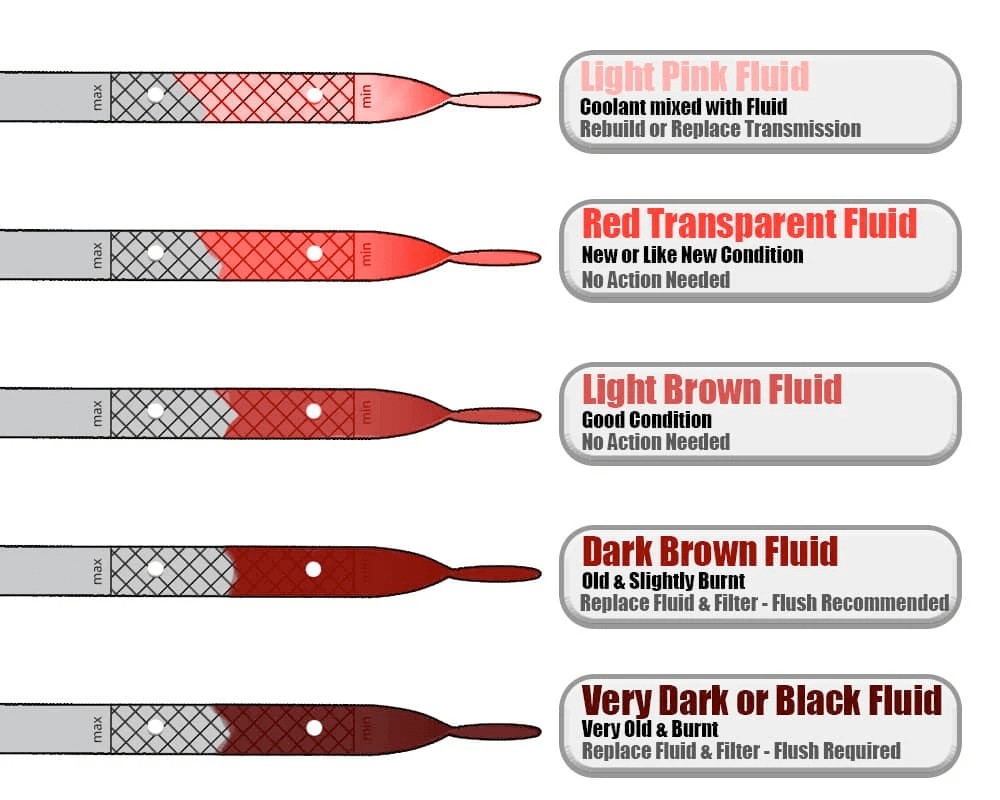Key Takeaways
- What the Colors Mean: Pink: Bad sign, water might have gotten in. Red: Good, fluid is new. Light Brown: Okay but getting old. Brown: Needs changing, it’s dirty. Black: Urgent change needed, it’s very dirty.
- Why Check: Knowing the fluid color helps spot problems early, saving you money on big repairs later.
- How to Check: Warm up your car, find the dipstick for transmission fluid, clean it, put it back in, then check the color on it.
When it comes to vehicle maintenance, understanding the color of transmission fluid can be helpful. Because the color of your fluid can tell you a lot about the overall health of your transmission. But what color should healthy transmission fluid be?
Healthy transmission fluid should look relatively clear or red in color. Transmission fluid that has become dirty or contaminated may look a deep red or brown in color. This indicates that that the fluid is in need of a change.
Assessing the color of your vehicle’s transmission fluid is a convenient way to determine its condition. Though not a precise method, it can still provide valuable information about the transmission’s overall health.
In this guide, we’ll be giving an in-depth look into how to identify the health of your transmission by the color of the fluid. Additionally, we’ll touch on how often one should check and maintain the fluid.
By understanding this essential aspect, you can ensure the longevity and optimal performance of your vehicle’s transmission system. Let’s dive into this!
Transmission Fluid Colors and Meanings
The color of tranny fluid provides valuable insights into its condition. While transmission fluid is typically red, it can also appear pink, light brown, dark brown, or black.
Let’s explore the meanings associated with these colors:
- Pink: May indicate the presence of water or coolant contamination, which can affect the transmission system’s performance and longevity.
- Red: Typically means new fluid with full protection.
- Light Brown: This is the most common color and signifies that the fluid is still in good condition, but beginning to get old.
- Brown: Indicates that the fluid is old and contaminated, potentially containing debris and contaminants that can damage the transmission components.
- Black: Indicates that the fluid has broken down in viscosity, and requires a change.

Why is Automatic Transmission Fluid Red?
Various fluids in vehicles are colored to make them easily distinguishable, and transmission fluid is no different. When transmission fluid is new, it has a semi-translucent red color, but as it is used over time, it becomes progressively darker.
Benefits of Regularly Checking Your Vehicle’s Transmission Fluid Color
Truth is, regularly checking your vehicle’s tranny fluid color offers a quick look into the overall health and performance of your car.
Because the color serves as a reliable indicator of potential issues that may be affecting your vehicle’s transmission system.
By occasionally checking the color, you can detect early signs of contamination, overheating, or even mechanical problems within the transmission.
Just keep in mind that red or light brown fluid indicates a well-functioning transmission. While a dark or discolored appearance may suggest the presence of dirt, debris, or fluid degradation.
Promptly identifying and addressing such issues can prevent major transmission damage and expensive repairs down the line.
So the next time you have your oil changed, ask the mechanic to check the tranny fluid as well. This will help keep an eye on the health of the fluid, and ensure optimal levels of fluid lubrication.
How to Check Your Vehicle’s Transmission Fluid Color
To check the color of your vehicle’s tranny fluid, you can follow a easy straightforward process.
First, make sure you park your vehicle on a level surface and engage the parking brake. Then, start the engine and allow it to idle for a few minutes to warm up the transmission fluid.
Next, locate the transmission dipstick, which is typically labeled and can be found near the back of the engine compartment. Take out the dipstick and use a lint-free cloth to wipe it clean. Once cleaned, reinsert the dipstick fully into its slot and then remove it again.
Now comes the important part. Observe the color of the fluid present on the dipstick and compare it to the recommended colors discussed for the transmission fluid.
By doing so, you can determine the condition of the fluid. If the color appears abnormal or significantly different from the recommended color, it would be wise to consider having your fluid changed.
Does Brand Matter for Transmission Fluid?
Yes, using the correct brand and viscosity of transmission fluid for your car is crucial for maintaining optimal performance and extending the lifespan of your vehicle’s transmission system.
Although there are many different brands of transmission fluid available, we usually advise using the one specified in your owner’s manual.
Each car manufacturer specifies the type and grade of transmission fluid that should be used for their vehicles, and it is essential to adhere to those recommendations.
Always consult your car’s manual first or seek professional advice to ensure you use the correct transmission fluid for your vehicle.
It is important to note that power steering fluid should never be used as a substitute for transmission fluid. While both fluids serve different functions, using power steering fluid in the transmission can lead to serious damage and costly repairs.
What Happens When the Wrong Tranny Fluid is Used?
Using the wrong transmission fluid can have several negative consequences. One of the main issues is inadequate lubrication.
When the wrong fluid is used, it compromises the lubricating properties of the transmission fluid. This, in turn, increases friction between the moving parts of the transmission and can lead to potential wear and tear.
Another problem that can arise from using the wrong fluid is overheating. Proper cooling is crucial for maintaining the optimal temperature in the transmission.
However, if the wrong fluid is used, it may hinder the cooling process and prevent the transmission from dissipating heat effectively. As a result, the transmission can overheat, causing potential damage to its components.
In addition, using the wrong fluid can also cause damage to seals and gaskets within the transmission. Many transmission fluids contain specific additives that help condition and seal these components.
When the wrong fluid is used, it can deteriorate the seals and gaskets, leading to leaks and fluid loss.
To avoid these problems, it is essential to use the correct type of transmission fluid recommended by the manufacturer for your vehicle.
Are All Brands of Transmission Fluid the Same?
Absolutely not. Different brands of transmission fluid contain unique blends of additives and friction modifiers. The correct transmission fluid for your vehicle depends on the specific recommendations outlined in your vehicle’s owner’s manual.
General Motors (GM)
- Recommended brands: ACDelco, Dexron
- Recommended type: Dexron VI ATF (Automatic Transmission Fluid)
Ford and Lincoln
- Recommended brands: Motorcraft, Mercon
- Recommended type: Mercon LV ATF (Automatic Transmission Fluid)
Dodge/RAM/Chrysler/Fiat
- Recommended brands: Mopar, ATF+4
- Recommended type: ATF+4 ATF (Automatic Transmission Fluid)
Toyota and Lexus
- Recommended brands: Toyota Genuine ATF, ATF WS
- Recommended type: ATF WS ATF (Automatic Transmission Fluid)
Honda and Acura
- Recommended brands: Honda ATF, ATF-DW1
- Recommended type: ATF-DW1 ATF (Automatic Transmission Fluid)
Nissan and Infiniti
- Recommended brands: Nissan Matic Fluid, Nissan CVT Fluid
- Recommended type: Nissan Matic Fluid for automatic transmissions, Nissan CVT Fluid for CVT transmissions
Subaru
- Recommended brands: Subaru ATF, Subaru CVT Fluid
- Recommended type: Subaru ATF for automatic transmissions, Subaru CVT Fluid for CVT transmissions
Hyundai
- Recommended brands: Hyundai Genuine ATF, Hyundai SP-IV-RR
- Recommended type: Hyundai SP-IV-RR ATF (Automatic Transmission Fluid)
Kia Motors
- Recommended brands: Kia Genuine ATF, Kia SP-IV-RR
- Recommended type: Kia SP-IV-RR ATF (Automatic Transmission Fluid)
Mitsubishi
- Recommended brands: Mitsubishi Genuine ATF, DiaQueen ATF SP III
- Recommended type: DiaQueen ATF SP III ATF (Automatic Transmission Fluid)
Tips for Maintaining Your Transmission Fluid
So now you know what color is transmission fluid, and most importantly what color is HEALTHY transmission fluid.
Always use high-quality fluids that meet the specifications outlined in the manual. So as an example, if you drive a Acura, use Honda/Acura ATF fluid.
Additionally, it’s important to regularly check the fluid level and color, as any changes can indicate potential issues.
By following the recommended maintenance schedule for fluid changes, you can effectively preserve the integrity of your transmission system.
Final Thoughts
Understanding what color tranny fluid should be is crucial for vehicle maintenance. By familiarizing yourself with the different colors and their meanings, regularly checking your fluid color, and using the correct type, you can ensure optimal performance and longevity for your vehicle’s drivetrain system.
Stay proactive and enjoy a smooth ride by knowing the importance of transmission fluid color.
Have a question? Add your comment below 👇

Managing Editor
Christopher is an automotive technical writer. When he’s not at the local autocross event, he can often be found working on one of his cars. Specializes in automotive class action law, industry trends, and automotive maintenance. Email me direct, or learn more about us

